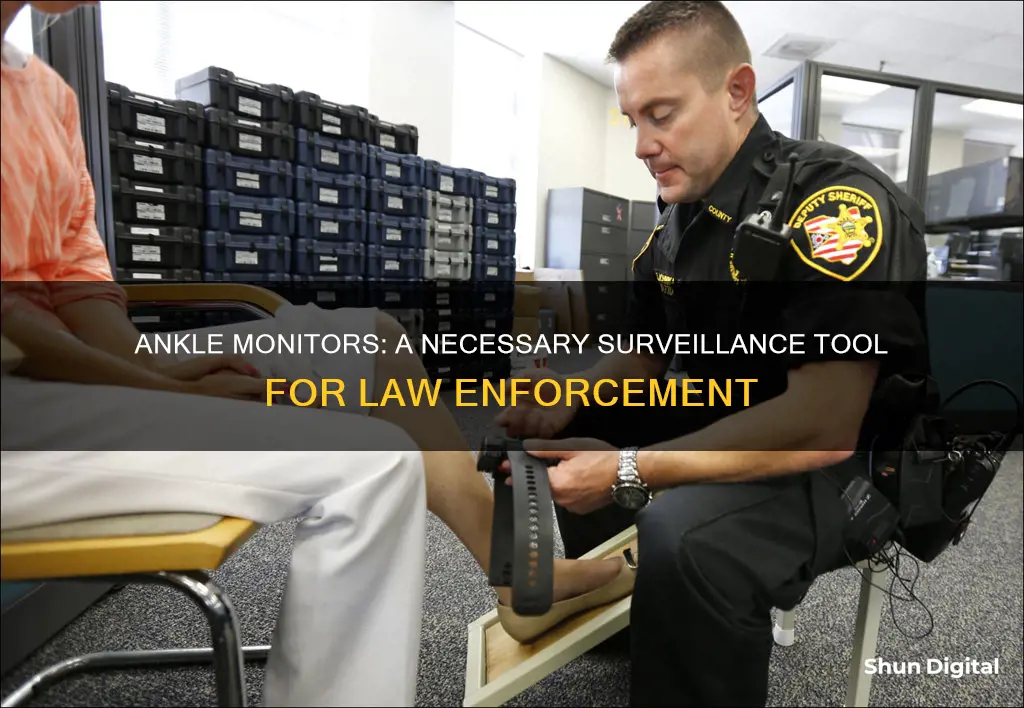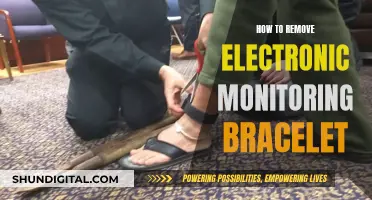
Ankle monitors, also known as electronic tags, are surveillance tools used by law enforcement to monitor individuals on parole, house arrest, or bail. They are typically used as an alternative to incarceration, allowing offenders controlled freedom while ensuring compliance with court-ordered movement restrictions. These devices use GPS or radio frequency technology to transmit location data to a monitoring center, alerting authorities if the wearer breaches their bond terms or movement restrictions. While ankle monitors are intended to reduce incarceration rates and ensure public safety, they have also been criticized for their negative impact on wearers' mental health, the stigma they carry, and their limited effectiveness in reducing recidivism.
| Characteristics | Values |
|---|---|
| Purpose | To ensure the wearer doesn't get into more trouble, to ensure the wearer's presence in court, to reduce bail, to act as an alternative to jail time, to supervise the wearer's location, to measure alcohol consumption |
| Wearers | People awaiting trial, people serving probation and parole, people facing immigration proceedings, DUI or DWI offenders, people convicted of serious crimes, repeat offenders, domestic violence offenders, people with alcohol-related offenses |
| Functionality | Transmits a signal to a base unit when the wearer goes outside a designated area, sends an alert to authorities if the wearer breaches their bond terms, can detect alcohol consumption through sweat analysis |
| Types | Radio Frequency (RF), Global Positioning System (GPS), Secure Continuous Remote Alcohol Monitoring (SCRAM) |
| Cost | Fees to wear these monitors range from $3 to $35 a day, with initial setup charges ranging from $100 to $200 |
| Effectiveness | Studies show that monitors may be less effective than other rehabilitation programs in discouraging further crimes |
| Issues | Expensive fees can amount to hundreds of dollars per month, monitors can cause social isolation and stress, electronic monitoring expands mass incarceration |
What You'll Learn

To ensure compliance with court-ordered movement restrictions
Ankle monitors are often used by police and law enforcement agencies as a surveillance tool to ensure compliance with court-ordered movement restrictions. These devices are typically locked securely onto an individual's ankle, employing GPS technology or radio frequency to transmit location data to a monitoring centre. This allows authorities to ensure that the wearer stays within the boundaries set by the court and complies with any specific conditions of their release. For example, individuals may be required to adhere to a curfew, refrain from drinking alcohol, or avoid certain people or locations.
The use of ankle monitors can serve as an alternative to pre-trial detention or as a condition of probation. In some cases, it may be used to reduce the amount of bail required for release. By agreeing to wear an ankle monitor, individuals promise to remain within a designated area and not flee, thereby reducing the risk of them skipping bail. This can increase the chances of the court offering a lower bail amount or even releasing the individual without bail.
Ankle monitors are commonly used for individuals who are deemed a danger to the community or a flight risk. They are also used for those who have committed alcohol-related offences, as the devices can detect alcohol consumption through sweat analysis. This feature is critical for enforcing restrictions on individuals who have been ordered by the court to refrain from drinking.
The ankle monitor system typically consists of three main components: the ankle bracelet, an on-site receiver, and a remote receiver. The ankle bracelet takes regular or constant readings of the wearer's location and transmits this data to the on-site receiver, usually located in the wearer's home. The data is then relayed to a remote receiver at a police station or monitoring service centre. If a breach is detected, such as the wearer leaving a designated area, the proper authorities are alerted and can take appropriate action.
While ankle monitors can provide controlled freedom for offenders and help maintain public safety, their effectiveness in discouraging further crimes has been questioned. Some studies suggest that rehabilitation programs may be more successful in reducing recidivism rates compared to electronic monitoring alone. Additionally, the use of ankle monitors has been criticised for exacerbating systemic inequities, particularly along lines of race, class, and disability.
Identifying Your ASUS Monitor: A Step-by-Step Guide
You may want to see also

To monitor alcohol consumption
Ankle monitors are often used by police to supervise an individual's location, typically for those under house arrest or on parole. However, they can also be used to monitor alcohol consumption, especially for those with alcohol-related offenses such as driving under the influence (DUI).
Alcohol-monitoring ankle bracelets, also known as Secure Continuous Remote Alcohol Monitor (SCRAM) bracelets, provide courts with a way to monitor offenders who are not supposed to be drinking alcohol. These devices are typically court-ordered for DUI cases but may also be used in other cases involving drug and alcohol use, such as domestic violence, underage drinking, or substance abuse charges.
SCRAM bracelets work by testing the wearer's perspiration for the presence of alcohol every 30 minutes. This is known as "transdermal" alcohol concentration, which measures the ethanol vapor leaving the skin. When a person consumes alcohol, a certain amount is metabolized and emitted as sweat through the skin pores. The SCRAM device detects this alcohol presence at the surface of the skin, specifically around the ankle. The test results are then wirelessly transmitted to a regional monitoring center, and if the defendant tests positive for alcohol, it is reported to the court.
In addition to monitoring alcohol consumption, SCRAM bracelets can also be equipped with GPS locators for house arrest situations, ensuring that the offender does not violate the terms of their house arrest. The use of these ankle monitors allows for ongoing, accurate monitoring of an individual's location and alcohol consumption, providing courts and probation departments with valuable data to enforce penalties or restrictions.
The cost of SCRAM bracelets includes an installation fee ranging from $50 to $100 and a daily monitoring fee of around $10 to $15, resulting in monthly costs that can be as high as $450 or more. These costs are typically charged to the defendant as part of their penalty for a DUI conviction.
Monitor Size on Linux: A Comprehensive Guide
You may want to see also

To reduce the prison population
Ankle monitors are used as an alternative to traditional imprisonment, allowing individuals to serve their sentences while remaining in the community. They are typically used for individuals on probation or parole, or those awaiting trial. They can also be used for people convicted of a crime but considered low-risk and not a danger to the community.
Ankle monitors are often touted as a more humane alternative to incarceration, allowing people to live at home and move about more freely than they would in prison. They are also less expensive than keeping someone in jail or prison, and they allow individuals to maintain their jobs and support their families. This can make it easier for them to reintegrate into society once their sentences are completed.
However, critics argue that ankle monitors are not a humane alternative to incarceration. They can be uncomfortable and cause skin irritation, and individuals with ankle monitors are often subject to strict rules and regulations. Any violation of these rules can result in additional penalties or even traditional imprisonment. The surveillance devices can also hurt people trying to get their lives back on track after prison, and there is no evidence that they are rehabilitative.
Ankle monitors can also be expensive, with private companies charging defendants hundreds of dollars a month to wear the devices. If people cannot pay, they may end up back in jail. Additionally, ankle monitors can cause medical complications, from cuts and bruises to electric shocks and difficulty breathing. They are also highly visible, which can lead to discrimination by employers, law enforcement, and the public.
While ankle monitors can help reduce the prison population by providing an alternative form of imprisonment, it is important to use them with discretion and consider the offender's risk of recidivism and the nature of the crime. They should be used as a complement to traditional imprisonment, not as a replacement.
Finding Monitor Size in Pixels: A Quick Guide
You may want to see also

To reduce the risk of bail bond forfeiture
Ankle monitors are often used as a condition of bail, with the purpose of ensuring the defendant appears in court and does not get into more trouble. They are typically used for people who are awaiting trial and are considered a danger to the community or a flight risk.
GPS ankle monitors can reduce the risk of bail bond forfeiture by making it easier to locate a defendant who decides to run. This decreases the risk of bail bond forfeiture for the bondsman, who could be liable for the entire bail amount if the defendant breaks bail conditions or disappears.
GPS ankle monitors also increase the certainty that the defendant will turn up for court proceedings, as they are notified if they go outside a designated area and authorities are alerted if they do not return. This helps to ensure the defendant's compliance with court-ordered movement restrictions and reduces the risk of them forfeiting their bail bond.
In addition, ankle monitors can save time and money that would otherwise be spent on trying to recover collateral assets if a defendant absconds. This makes it a win-win for both the defendant and the bondsman, as it increases the chances of the defendant appearing in court and reduces the financial burden on the bondsman.
Removing Monitor Tilt Stand: A Step-by-Step Guide for L197 Models
You may want to see also

To ensure compliance with bail conditions
Ankle monitors are often used as a condition of bail, to ensure compliance with court-ordered movement restrictions. Typically, they are used for people awaiting trial who are considered a danger to the community or a flight risk. The monitors allow the authorities to track the wearer's location, usually via GPS or radio frequency technology. This data is transmitted to a monitoring centre, which alerts the relevant authorities if the wearer breaches their bail conditions, for example, by leaving their designated area.
The use of ankle monitors can help to reduce the prison population by providing an alternative to pre-trial detention. They are also used as a condition of probation, allowing offenders to be punished without being placed in prison. In some cases, ankle monitors can be used to enforce restrictions on alcohol consumption, which is particularly relevant for individuals with alcohol-related offences such as driving under the influence. These monitors analyse the wearer's sweat to detect alcohol and notify the relevant authorities if the wearer violates the terms of their release.
In addition to their use in the criminal justice system, ankle monitors are also employed in immigration contexts and healthcare settings. For example, in the case of individuals with dementia, ankle monitors can be used to prevent them from wandering away and becoming lost.
While ankle monitors can provide a level of freedom and flexibility for the wearer, there are also concerns about the effectiveness of these devices in reducing recidivism. Some studies suggest that other rehabilitation programs may be more successful in discouraging further crimes. Additionally, the use of ankle monitors has been criticised for exacerbating systemic inequities, particularly along lines of race and class. The fees associated with wearing an ankle monitor can be significant, creating a financial burden for individuals and households.
Finding the Studio Monitor Sweet Spot: Where to Place Your Speakers
You may want to see also
Frequently asked questions
Ankle monitors are used by police as a surveillance tool to ensure compliance with court-ordered movement restrictions. They are often used as an alternative to incarceration.
Ankle monitors are typically used for people awaiting trial, serving probation and parole, or facing immigration proceedings. They are usually reserved for those considered a danger to the community or a flight risk.
Ankle monitors use GPS technology or radio frequency to transmit location data to a monitoring center. They are locked in place to allow for ongoing, accurate monitoring, and some units have built-in sensors that notify authorities if tampered with.
Ankle monitors can help reduce prison overpopulation and provide a less restrictive alternative to incarceration. They also allow for ongoing supervision of offenders without the need for constant physical surveillance by law enforcement officers.
Ankle monitors have been criticized for their potential to stigmatize and isolate wearers, infringe on privacy and human rights, and exacerbate systemic inequities along lines of race, class, and disability. Additionally, studies suggest that they may be less effective than other rehabilitation programs in discouraging further crimes.







